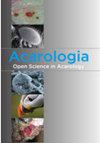不同棉花品种上persimilphytoseiulus (Phytoseiidae)取食荨麻叶螨(Acari: tetranyciae)的捕食能力及功能响应
IF 0.9
3区 农林科学
Q3 ENTOMOLOGY
引用次数: 0
摘要
本研究旨在测定Phytoseiulus persimilis Athias Henriot(Acari:Phytoseidae)对六个不同叶片特征的棉花品种(Gloria、Lima、Carla、DP-396、Edessa、ST-468)的二斑叶螨(Acari)的捕食性能。将6种猎物密度(5、10、20、40、80和160)的猎物的卵和原若虫阶段分别提供给一只雌性捕食者,以确定其24小时的捕食和产卵率。结果表明,无论棉花品种如何,波斯小蠊都对二斑潜蝇的卵期和原若虫期表现出II型功能反应。当捕食者以蛾卵和原若虫为食时,对Gloria(低毛密度)品种的最高攻击率(α)分别为0.045 h和0.085 h。不同棉花品种间,以二斑潜蝇卵为食的波斯小蠊与原若虫的处理时间(Th)有很大的相似性。在不同棉花品种中,以二斑潜蝇卵为食的波斯小蠊的食物消耗量没有显著差异。相反,与毛体密度较高的品种(Edessa和ST-468)相比,毛体密度较低的品种(Gloria和Lima)在所有原若虫密度下(160除外)的波斯小蠊的食物消耗量显著较高。目前的研究表明,棉花植株的叶片毛状体密度影响了波斯小蠊对二斑潜蝇原若虫的捕食能力。然而,还需要更多的研究来从更广泛的角度来解决这个问题,特别是在田间条件下观察P.persimilis对棉花品种的表现和生物防治潜力。本文章由计算机程序翻译,如有差异,请以英文原文为准。
Prey consumption capacity and functional response of Phytoseiulus persimilis (Acari: Phytoseiidae) feeding on Tetranychus urticae (Acari: Tetranychidae) on different cotton varieties
This study aimed to determine the predatory performance of Phytoseiulus persimilis Athias-Henriot (Acari: Phytoseiidae) against Tetranychus urticae Koch (Acari: Tetranychidae) on six different cotton varieties (Gloria, Lima, Carla, DP-396, Edessa, ST-468) with different leaf characteristics. The eggs and the protonymph stages of the prey with six prey densities (5, 10, 20, 40, 80 and 160) were separately offered to a single female predator to determine its predation and oviposition rates for 24h. The results showed that P. persimilis exhibited a Type II functional response to both egg and protonymphal stages of T. urticae irrespective of cotton varieties. The highest attack rates (α) were 0.045 h- and 0.085 h- when the predator fed on eggs and protonymphs of T. urticae on Gloria (low trichome density) variety, respectively. There was a great similarity between the handling times (Th) of P. persimilis feeding on T. urticae eggs and protonymphs among different cotton varieties. No significant difference was found in terms of food consumption of P. persimilis fed on T. urticae eggs in different cotton varieties. In contrast, food consumptions of P. persimilis in all protonymph densities (except 160) were significantly higher on varieties with lower trichome density (Gloria and Lima) compared to the varieties with higher trichome density (Edessa and ST-468). The current study showed that the leaf trichome density of the cotton plant affected the prey consumption capacity of P. persimilis on T. urticae protonymphs. However, more studies are needed to address the issue from a wider perspective, especially to observe the performance and biological control potential of P. persimilis on cotton varieties under field conditions.
求助全文
通过发布文献求助,成功后即可免费获取论文全文。
去求助
来源期刊

Acarologia
ENTOMOLOGY-
CiteScore
2.00
自引率
18.20%
发文量
81
期刊介绍:
Acarologia is a free open-access journal. Please help us by submitting manuscripts in accordance with following instructions.
All manuscripts which do not conform to the instructions will be returned to authors without the benefit of review.
Acarologia publishes the results of original research on all aspects of Acarology.
The journal policy is that taxonomic descriptions should include several species within a same genus/family, when possible.
The editors reserve the right to refuse manuscripts when authors intentionally divide individual species descriptions of the same genus/family into distinct publications.
Single species descriptions should be clearly justified based on their scientific interest.
 求助内容:
求助内容: 应助结果提醒方式:
应助结果提醒方式:


